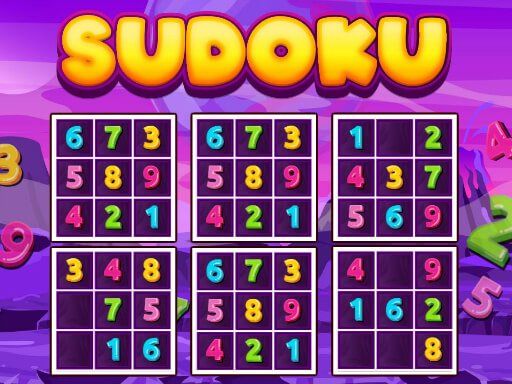
Introduction
How to Play the Game Sudoku – Greetings, readers! Welcome to the intriguing world of Sudoku, a logic-based puzzle that has captivated minds worldwide. Whether you’re a novice or a seasoned solver, this comprehensive guide will walk you through the steps to master this enigmatic game.
Sudoku puzzles consist of a 9×9 grid, further divided into 3×3 blocks. The goal is to fill each cell with a number from 1 to 9, ensuring that no number is repeated within the same row, column, or 3×3 block. This seemingly simple objective requires a combination of logical thinking, patience, and perhaps a hint of intuition.
Understanding the Basics: The Rules of Sudoku
Row, Column, and Block Restrictions
As mentioned earlier, Sudoku’s fundamental rule is the avoidance of repetition. Each number from 1 to 9 must appear exactly once:
- Rows: Within each of the 9 rows, all numbers from 1 to 9 must be present.
- Columns: Similarly, within each of the 9 columns, all numbers from 1 to 9 must be present.
- Blocks: The 9×9 grid is further divided into 9 smaller 3×3 blocks. Each block must also contain all numbers from 1 to 9.
Given Clues: Starting Points
Sudoku puzzles are not entirely blank slates. When you begin, some cells will already be filled with numbers. These are the “given clues.” They provide a starting point and guide your logical deductions.
Playing Sudoku: Step-by-Step Strategy
Scanning for Single Options
Begin by scanning the grid for cells with only one possible answer. This occurs when a number from 1 to 9 is missing in a specific row, column, or block. Once identified, fill in the cell with the missing number.
Process of Elimination
If a cell doesn’t have an immediately apparent solution, use the process of elimination. Start by checking the corresponding row, column, and block. If a number is already present in any of those segments, it cannot be the answer for the current cell.
Naked Pairs and Triples
“Naked pairs” and “naked triples” refer to situations where two or three cells within a row, column, or block only allow specific numbers. These identified pairs or triples can eliminate those numbers as possibilities for nearby empty cells.
Hidden Pairs, Triples, and Quadruples
Hidden pairs or triples occur when two or three numbers are the only possible candidates for multiple empty cells within the same row, column, or block. Identifying these can be a bit trickier, but similar to naked pairs, they can be used for deductive reasoning.
Intermediate and Advanced Techniques
GUESStimate: Smart Guessing
For more challenging puzzles, it’s sometimes necessary to make educated guesses. Use the process of elimination to narrow down the options and then make a logical guess. If the guess leads to a contradiction, backtrack and change it.
Swordfish and X-Wing Techniques
Swordfish and X-wing techniques are more advanced strategies that involve complex patterns within rows, columns, and blocks. They can help unlock seemingly impossible puzzles. However, they require a keen eye and a thorough understanding of Sudoku logic.
Sudoku Tables: An Overview
| Element | Description | Sudoku Relevance |
|---|---|---|
| Grid | A 9×9 grid | Base structure of a Sudoku puzzle |
| Cell | An individual square within the grid | Needs to be filled with a number from 1 to 9 |
| Block | A 3×3 subset within the grid | Must contain all numbers from 1 to 9 |
| Row | A horizontal line in the grid | Must contain all numbers from 1 to 9 |
| Column | A vertical line in the grid | Must contain all numbers from 1 to 9 |
| Given Clues | Pre-filled numbers in the grid | Provide starting points and guidance |
| Naked Pairs/Triples | Cells with only two or three possible numbers | Can be used for deduction |
| Hidden Pairs/Triples | Pairs or triples that aren’t immediately apparent | Require closer examination |
Conclusion
Congratulations! By now, you should have a solid grasp of how to play the game Sudoku. Remember, practice makes perfect. The more you solve, the sharper your logical reasoning skills become. Keep your mind active and enjoy the satisfaction of solving even the most challenging Sudoku puzzles.
Don’t forget to check out our other articles on Sudoku strategies, tips, and variations to enhance your Sudoku prowess even further. Happy puzzling!
FAQ about Sudoku
What is Sudoku?
Sudoku is a logic-based puzzle game where the objective is to fill a 9×9 grid with digits from 1 to 9, so that each row, column, and 3×3 block contains each digit exactly once.
How do I play Sudoku?
Start by filling in any obvious numbers (e.g., numbers that are already given in the grid). Then, look for rows, columns, or blocks that have only one possible number that can be filled in. Continue this process until all cells in the grid are filled.
What if I get stuck?
If you get stuck, try using a pencil and eraser to fill in possible numbers in the empty squares. This will help you visualize the possible solutions.
What are the rules of Sudoku?
- Each row must contain the digits 1 to 9.
- Each column must contain the digits 1 to 9.
- Each 3×3 block must contain the digits 1 to 9.
- No digit can be repeated in any row, column, or block.
Tips for playing Sudoku?
- Start with the rows, columns, or blocks that have the most obvious numbers filled in.
- Look for patterns and relationships between the numbers.
- Use a pencil and eraser to mark possible numbers in empty squares.
- Don’t guess! If you’re not sure about a number, leave it blank until you can find a logical reason for filling it in.
What are the different levels of difficulty in Sudoku?
Sudoku puzzles typically come in three levels of difficulty: easy, medium, and hard. Easy puzzles have more numbers already filled in, while hard puzzles have fewer numbers and more complex patterns.
What is a “hidden single”?
A hidden single is a number that can only appear in one square in a row, column, or block, even though it is not immediately obvious.
What is a “naked pair”?
A naked pair is a pair of numbers that can only appear in two squares in a row, column, or block. All other squares in that row, column, or block cannot contain those numbers.
What is a “pointing pair”?
A pointing pair is a pair of numbers that can only appear in two squares in a block, and those two squares are in the same row or column outside of the block. This means that those numbers cannot appear in any other squares in that row or column outside of the block.
What is a “Box-X Wing”?
A Box-X Wing is a pattern of four squares in a block, where the same two numbers appear in each row or column of those squares, but in different blocks. This means that those numbers cannot appear in any of the other squares in those rows or columns, regardless of which block they are in.





